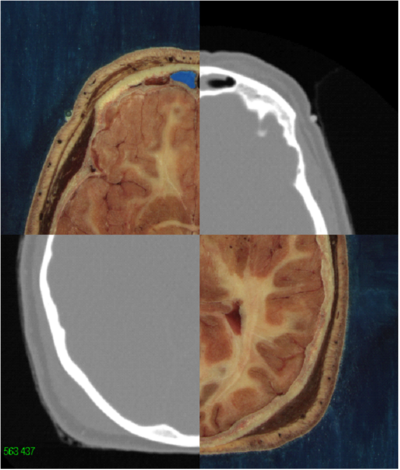Difference between revisions of "ITK"
| Line 1: | Line 1: | ||
== It started in 1995 at a meeting in the National Library of Medicine Board of Regents conference room. == | == It started in 1995 at a meeting in the National Library of Medicine Board of Regents conference room. == | ||
<div class="floatright">[[Image:RGBtoCT.png|thumb|400px|Registration of the Visible Human Male CT and RGB Data done with ITK.]]</div> | <div class="floatright">[[Image:RGBtoCT.png|thumb|400px|Registration of the Visible Human Male CT and RGB Data done with ITK.]]</div> | ||
| − | [http://www.itk.org/ The Insight Toolkit], ITK, is one of several initiatives of the NIH | + | [http://www.itk.org/ The Insight Toolkit], ITK, is one of several initiatives of the [http://nih.gov/ NIH] |
[http://www.nlm.nih.gov/ National Library of Medicine] (NLM) [http://www.nlm.nih.gov/research/visible/visible_human.html Visible Human Project]. In the early | [http://www.nlm.nih.gov/ National Library of Medicine] (NLM) [http://www.nlm.nih.gov/research/visible/visible_human.html Visible Human Project]. In the early | ||
1990's NLM, through its contractors, created 3D representations of a | 1990's NLM, through its contractors, created 3D representations of a | ||
Latest revision as of 15:12, 30 October 2009
It started in 1995 at a meeting in the National Library of Medicine Board of Regents conference room.
The Insight Toolkit, ITK, is one of several initiatives of the NIH National Library of Medicine (NLM) Visible Human Project. In the early 1990's NLM, through its contractors, created 3D representations of a normal human male and female. The data includes physical cross-section, computed tomography and MRI images. The Visible Human Male and Visible Female have been available to the public since 1995.
In 1995, Dr. Michael Ackerman from NLM held a meeting with several individuals to see what next steps should be taken to promote the Visible Human data. This group identified a need for a public software to process the datasets. Terry Yoo, a PhD student at UNC was in attendance as well as Bill Lorensen from GE Research.
Fast forward to April 1, 1999. Terry Yoo, then a Project Officer at NLM, and Dr. Ackerman, solicited proposals to build a segmentation and registration tool kit to process the Visible Human data. The Request for Proposals (RFP) stated in part:
"NLM is seeking competitive proposals to develop an application programmer interface (API) and first implementation of a Segmentation and Registration Toolkit (SRT). The resulting system should be suitable for computer assisted exploration of the NLM Visible Human Project (VHP) Male and Female data sets. The final deliverable product of this SRT version is to be beyond a beta prototype stage, compatible for direct insertion into the public domain via internet access through the NLM. The goal of this initiative is to create a self-sustaining code development effort to support image analysis research in segmentation, classification, and deformable registration of medical images. The design should include future expansion to parallel implementations and large memory requirements. The final delivery version will be required to be engineered to accommodate change by periodic and incremental modifications."
Several institutions responded and via a peer review process, six contractors were selected three commercial (Kitware, GE Corporate R&D, and Insightful), and three academic (UNC Chapel Hill, University of Utah, and University of Pennsylvania). Several subcontractors included: U Pitt, Columbia, and Brigham and Women's Hospital. The initial contract period was three years.
After organizational meetings in November 1999 and January 2000, the contractors began the process to create, from scratch, what is now called ITK. From the start, the group decided to broaden the application of the tool kit to biomedical imaging. As part of their proposals, both GE and Kitware proposed use "extreme programming" which they had been successfully using for VTK development. To that end, NLM funded CMake, CableSwig and Dart.For the next three years, the contractors worked to created a robust, feature rich and extensible tool kit.
The first code was checked into the cvs repository in March 2000. A workable image class was made available to the contractors in June 2000. The first public release, ITK 1.4, was made in September 2003.
After the release, NLM awarded several Algorithms, Adapters, and Data Distribution (A2D2) contracts to test the software architecture of ITK as well as the design of the API. NLM also extended the contracts for several of the original contractors.
Today, NLM still supports ITK through maintenance contracts but the bulk of the work is done by the growing, international ITK community.
